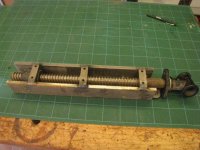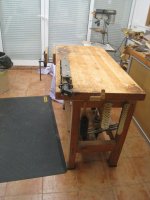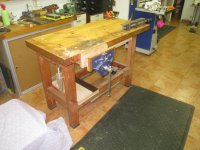Toni Ciuraneta
Member
- Messages
- 5,629
- Location
- Catalunya
Alrright guys.
Some years ago I got this tail vise hardware almost for free, and at that time I had other priorities than making a new bench or installing it in my existing one.
Today while I was tidying my shop it came to my hands again and I want to make use of it rather than letting it rust.

The problem is that my bench is quite short 52" ony and this guy is 18,5" so almost half of the length of the bench. On top of that my bench is only 2" thick and this guy is 3-1/8 which means that the bench top should be at least 4" thick. I would benefit of having a longer and wider bench but not very much as my shop is small.
So here are my options not in order of preference.
Try to retrofit my bench with it.
Make a new bench
Start making the wooden part around it to eventually either fit it in my bench or on a new bench to make.
So what would you do? any of the solutions are time consuming, and some more expensive than others.
Some years ago I got this tail vise hardware almost for free, and at that time I had other priorities than making a new bench or installing it in my existing one.
Today while I was tidying my shop it came to my hands again and I want to make use of it rather than letting it rust.

The problem is that my bench is quite short 52" ony and this guy is 18,5" so almost half of the length of the bench. On top of that my bench is only 2" thick and this guy is 3-1/8 which means that the bench top should be at least 4" thick. I would benefit of having a longer and wider bench but not very much as my shop is small.
So here are my options not in order of preference.
Try to retrofit my bench with it.
Make a new bench
Start making the wooden part around it to eventually either fit it in my bench or on a new bench to make.
So what would you do? any of the solutions are time consuming, and some more expensive than others.



